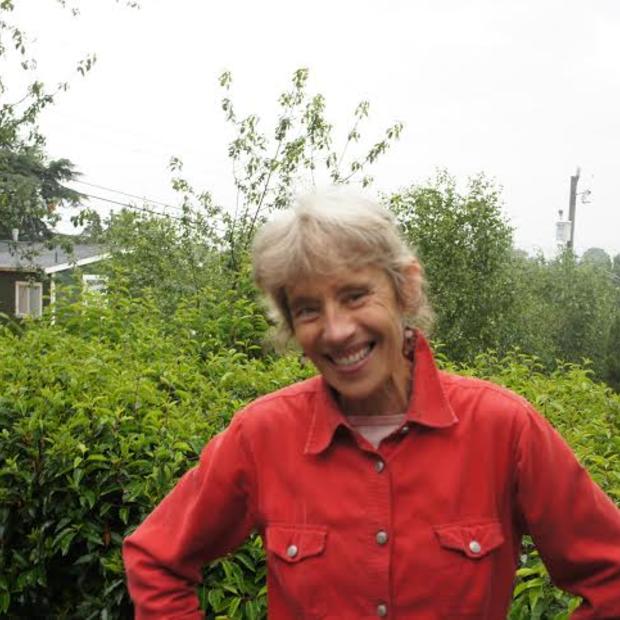In this first of a two-part series, Martha Baskin brings us to the world of urban habitat restoration — rescuing trees from invasive ivy and clearing rivers and streams of urban detritus. The work is a joint effort of the Green Seattle Partnership, non-profits, and volunteers, who play a critical role in making it happen.
Click on the audio player above or here to listen.
You might call it “old growth occupation.” Enter a park, in this case Seward Park, home to one of the city’s few old growth forests. Bring as many volunteers as possible. Cut away invasive ivy and blackberry. Mulch the soil and plant native species. What do you get?
The likely probability old growth trees like Doug fir, hemlock, and Pacific Madrone will survive another hundred years. Kelly O’Callahan is Senior Volunteer Specialist with EarthCorps, a non-profit committed to environmental service and global community. “ Seward Park is really unique in the fact that it was one of the few places in the city that wasn’t logged when the area was settled," she says, "so we’re lucky to have those trees that have been here for more than a hundred years.”
Though old growth and a fairly healthy forest have curbed some of the invasive ivy and blackberry endemic to the region, O'Callahan says, “we’re starting to see them invade a little bit, so by doing this work we’re doing today we’re preserving the awesome huge trees that exist here.”
Preserving 'awesome huge trees' is the goal of EarthCorps and the Green Seattle Partnership, a joint project by the city, non-profits, schools, and business. Centuries of logging, followed by waves of development, and the planting of non-native species interrupted the natural role of trees in curbing storm run-off, intercepting rain, and clearing particulates from the air.
Seattle Parks Urban Forester, Mark Mead, calls trees “green infrastructure.” “One of the things we’re trying to figure out is what would it take to replace the storm water retention value of those trees with storm water infrastructure, containment and those types of things,” he explains. The guesstimate is between ten and eleven million dollars. The city’s goal is to increase green infrastructure, of the tree variety, from 22 percent to 30 percent by 2025.
“We need to create sustainable canopy and we have to understand which trees are going to do best in which areas and how we’re going to take care of them.”
Financing, good management, and community buy-in are essential. Traditionally, resources to restore tree canopy have been limited. A three million dollar investment from Forterra, the non-profit formerly Called the Cascade Land Conservancy, gave the Green Seattle Partnership a healthy jump-start several years ago. Coupled with park levy monies and earmark grants for specific sites, the investment set Green Seattle Partnership well on its way to “re-leafing” the city.
Even with funding, the partnership relies on volunteer labor to make their initiatives happen. Take Seattle University student Joe Kirk. His Environmental Politics class requires service learning. But the chance to be outside suits him fine. The class is studying what Kirk calls the environmental crisis through the lens of political science. “We’re examining past policy and options for future policy to help promote the environmental movement and also prevent the impending environmental crisis,” he says.
Does cutting back invasive blackberries count? “Yes, definitely. The work we’re doing is very slow progress and we may not see the immediate effect on the forest, but the biggest thing is making people aware and I know EarthCorps does a great job with that.”
Another volunteer, Nicholas Standish, works close by. Standish hopes to accumulate volunteer hours with Green Seattle Partnership so he can transition from landscape work to habitat restoration. “We have to restore as much of the urban forest as we can because most of it has been devastated over the last one hundred, one hundred fifty years,” he says.
Joana Otero Matis, an EarthCorps Volunteer Specialist from Portugal, pauses to wonder whether too much blackberry is being cut. “We are approaching nest season and we don’t want to disturb the birds when they are already nesting,” she explains. But time is on her side. Volunteers will clear as much as they can today and come back later to dig the roots.
Across the road from this grove of conifers and hemlock is an area some call Lost Lake, the name found on an old map from 1912. Paul Talbert works with the Friends of Seward Park, another partner in the Green Seattle Partnership. Several years ago the area was nothing but blackberries. No light could penetrate the forest floor, so nothing could germinate.
“Several years ago they came in and cleared the blackberries out and some of these firs were planted," he says. "It’s an example of taking out the invasive plants and having the native vegetation come roaring back.”
Perhaps not always with a roar, but as today’s volunteers demonstrate, with steady commitment, hard work, and many hands.
Green Acre Radio is supported by the Human Links Foundation. Engineering by CJ Lazenby. Produced through the Jack Straw Foundation and KBCS.



